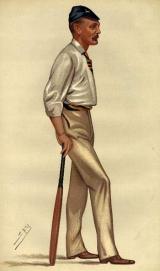Underarm but not underhand
|
|

|
There have been many instances in cricket where a wicketkeeper has been brought on to bowl, usually at the end of matches which are meandering to a draw. Occasionally it produces something remarkable - in 1965 Alan Smith of Warwickshire took a hat-trick in such circumstances - but more often that not it's little more than an amusing distraction.
But the most extraordinary example of it came on the second day of the Oval Test between England and Australia in 1884. England had a 1-0 series lead courtesy of a win in the second Test, and the sides arrived in London for the final Test with England needing a draw to retain the fledgling Ashes. That was made easier by the fact that Tests in England then were only three days long.
Australia won the toss, batted, and closed the first day on 362 for 2. Lord Harris, England's captain, chopped and changed his bowlers to no effect. He used ten during the day, and the last player he turned to late on was the Hon Alfred Lyttelton.
Lyttelton, one of the great all-round sportsmen of his day, was an excellent keeper and one of the first to stand up to the quicker bowlers without needing a long stop. What he most certainly was not was a bowler. He had never taken a first-class wicket on the rare occasions he had turned his arm over. On that first evening he bowled medium pacers to no effect. Bell's Life went so far as to describe his bowling as "very erratic, the ball generally going wide on the leg side".
Australia continued where they left off the next day, and by the middle of the afternoon were cruising at 532 for 6. This game took place before declarations were allowed so it was very much a case of hit out or get out as far as the Australians were concerned. Shortly before 4pm, Harris again asked Lyttelton to bowl from the Vauxhall End. Lyttelton merely handed his gloves to WG Grace and began to bowl in his pads. Unlike the previous evening, he opted for underarm lobs rather than anything quicker. "The change caused some laughter," noted The Guardian, adding that it grew after what happened next.
With his first ball, looped down the leg side, Billy Midwinter swung wildly and the ball lodged in Grace's gloves more than him catching it. Lyttelton appealed, Grace did not, but the umpire gave him out. "I had no time to prevent the umpire giving his decision," Grace recalled, "so Midwinter had to go." When the bowling was from the Pavilion End, Lyttelton took back the gloves and kept wicket normally.
|
|

|
Fred Spofforth drove Shrewsbury for four before being bowled by Lyttelton and finally Harry Boyle was caught by Lord Harris, running in from mid-on. Lyttelton had taken 4 for 8 on the day, 4 for 19 overall. They were to be the only four wickets of his career. At the other end, Shrewsbury had bowled three of the four overs he was to send down in first-class cricket.
Australia were bowled out for 551 but had taken more than half the available playing time in doing so. They dismissed England for 346 and enforced the follow-on but had little more than a hour to bowl at England for a second time and so the match fizzled out to a draw.
Bibliography
WG Grace: A Life by Simon Rae (Faber & Faber, 1998)
The Cricketer
Is there an incident from the past you would like to know more about? Email us with your comments and suggestions.
Martin Williamson is executive editor of Cricinfo

